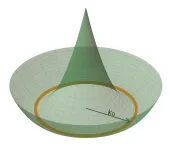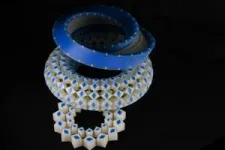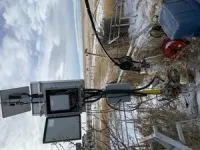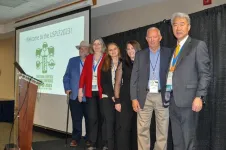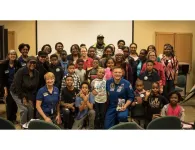(Press-News.org) AMHERST, Mass. – A team of physicists, including University of Massachusetts assistant professor Tigran Sedrakyan, recently announced in the journal Nature that they have discovered a new phase of matter. Called the “chiral bose-liquid state,” the discovery opens a new path in the age-old effort to understand the nature of the physical world.
Under everyday conditions, matter can be a solid, liquid or gas. But once you venture beyond the everyday—into temperatures approaching absolute zero, things smaller than a fraction of an atom or which have extremely low states of energy—the world looks very different. “You find quantum states of matter way out on these fringes,” says Sedrakyan, “and they are much wilder than the three classical states we encounter in our everyday lives.”
Sedrakyan has spent years exploring these wild quantum states, and he is particularly interested in the possibility of what physicists call “band degeneracy,” “moat bands” or “kinetic frustration” in strongly interacting quantum matter.
Typically, particles in any system bump into each other, and in so doing they cause predictable effects, like billiard balls knocking into each other and then reacting in a predictable pattern. In other words, the effects and the particles are correlated. But in a frustrated quantum system, there are infinite possibilities that stem from the interaction of particles—perhaps the billiard ball levitates or zooms off at an impossible angle—and some of these infinite possibilities can lead to novel quantum states.
What Sedrakyan and his colleagues have done is to engineer a frustration machine: a bilayer semiconducting device. The top layer is electron-rich, and these electrons can move freely. The bottom layer is filled with “holes,” or places that a roving electron can occupy. Then the two layers are brought extremely close together—interatomic close.
If the number of electrons in the top layer and holes in the bottom layer were equal, then you would expect to see the particles acting in a correlated manner, but Sedrakyan and his colleagues designed the bottom layer so that there is a local imbalance between the number of electrons and holes in the bottom layer. “It’s like a game of musical chairs,” Sedrakyan says, “designed to frustrate the electrons. Instead of each electron having one chair to go to, they must now scramble and have many possibilities in where they ‘sit’”.
This frustration kicks off the novel chiral edge state, which has a number of surprising characteristics. For instance, if you cool quantum matter in a chiral state down to absolute zero, the electrons freeze into a predictable pattern, and the emergent charge-neutral particles in this state will all either spin clockwise or counterclockwise. Even if you smash another particle into one of these electrons, or you introduce a magnetic field, you can’t alter its spin—it’s surprisingly robust and can even be used to encode digital data in a fault-tolerant way.
Even more surprisingly is what happens when an outside particle does smash into one of the particles in the chiral edge state. To return to the billiard-ball metaphor, you would expect to send the eight-ball flying when the cue ball smacks into it. But if the pool balls were in a chiral bose-liquid state, all 15 of them would react in exactly the same way when the eight-ball was struck. This effect is due to the long-range entanglement present in this quantum system.
It is difficult to observe the chiral bose-liquid state, which is why it has remained hidden for so long. To do so, the team of scientists, including theoretical physicists Rui Wang and Baigeng Wang (both of Nanjing University) as well as experimental physicists Lingjie Du (Nanjing University) and Rui-Rui Du (Peking University) designed a theory and an experiment that used an extremely strong magnetic field that is capable of measuring the movements of the electrons as they race for chairs.
“On the edge of the semiconductor bilayer, electrons and holes move with the same velocities,” says Lingjie Du. “This leads to helical-like transport, which can be further modulated by external magnetic fields as the electron and hole channels are gradually separated under higher fields.” The magneto-transport experiments therefore successfully reveal the first piece of evidence of the chiral bose-liquid, which the authors also call the “excitonic topological order” in the published paper.
This work was supported by the National Key R&D Program of China, the National Natural Science Foundation of China, the Program for Innovative Talents and Entrepreneurs in Jiangsu, the Xiaomi Foundation, the Chinese Academy of Sciences, and the National Science Foundation.
Contacts: Tigran Sedrakyan, tsedrakyan@physics.umass.edu
Daegan Miller, drmiller@umass.edu
END
For experimental physicists, quantum frustration leads to fundamental discovery
“Chiral bose-liquid state” is a new phase of matter, according to UMass Amherst professor
2023-06-14
ELSE PRESS RELEASES FROM THIS DATE:
Metamaterials with built-in frustration have mechanical memory
2023-06-14
Researchers from the UvA Institute of Physics and ENS de Lyon have discovered how to design materials that necessarily have a point or line where the material doesn’t deform under stress, and that even remember how they have been poked or squeezed in the past. These results could be used in robotics and mechanical computers, while similar design principles could be used in quantum computers.
The outcome is a breakthrough in the field of metamaterials: designer materials whose responses are determined by their structure rather than their chemical composition. To construct a metamaterial with mechanical memory, physicists ...
Earth was created much faster than we thought. This makes the chance of finding other habitable planets in the Universe more likely
2023-06-14
When we walk around in our everyday life, we might not think of the Earth itself very often. But this planet is the foundation of our life. The air we breathe, the water we drink and the gravity that pins us to the ground.
Up until now, researchers believed that it took more than 100 million years for the Earth to form. And it was also common belief that water was delivered by lucky collisions with water-rich asteroids like comets.
However, a new study from the University of Copenhagen suggests that it might not have happened entirely by chance.
“We show that the Earth formed by the very ...
A scorching-hot exoplanet scrutinized by UdeM astronomers
2023-06-14
An international team led by Stefan Pelletier, a Ph.D. student at Université de Montréal's Trottier Institute for Research on Exoplanets announced today having made a detailed study of the extremely hot giant exoplanet WASP-76 b.
Using the MAROON-X instrument on the Gemini-North Telescope, the team was able to identify and measure the abundance of 11 chemical elements in the atmosphere of the planet.
Those include rock-forming elements whose abundances are not even known for giant planets in the Solar System such as Jupiter or Saturn. The team's study is published in ...
A growing number of producers and industries interested in precision livestock farming
2023-06-14
Some of the world’s best minds that are focused on profitable and sustainable livestock production attended and presented at the recent Second U.S. Precision Livestock Farming Conference. Hosted by University of Tennessee AgResearch, the May 21-24 event at the UT Conference Center in Knoxville attracted 219 attendees representing 22 countries and 32 U.S. states. Participants included academics, representatives of government agencies and allied industries as well as producers. The conference had a central theme of “Field Application of PLF Technologies” and academic presentations along with two industry and producer panels included interactive dialogues among the attendees ...
It takes a village: Study shows community is key to a sustained passion for science among adolescents
2023-06-14
The results of a yearlong science program show that one of the best ways to instill a lasting interest in science among children is to engage them alongside their family members. This finding runs counter to the current framework, in which children attend science-related summer camps and after-school programs apart from their families, diminishing the long-term potential of what they learn.
“We wanted to see if we could support families as a whole, as opposed to giving a student a really amazing one-off experience and sending them ...
Racial disparities found in one of first studies of pharmacological treatment of insomnia
2023-06-14
INDIANAPOLIS — In one of the first studies to investigate racial disparities in the pharmacologic treatment of insomnia, researchers from Regenstrief Institute and Indiana University report that patients belonging to racial minority groups were significantly less likely to be prescribed medication following diagnosis of insomnia than White patients.
The study found that Black patients were much less likely to have been prescribed an FDA-approved insomnia medication at any time post diagnosis than White patients. Other non-White individuals were significantly less likely to be prescribed an FDA-approved medication two, three, and four years after insomnia diagnosis ...
New York Academy of Sciences, Leon Levy Foundation name first 10 Leon Levy Scholars in Neuroscience
2023-06-14
New York, NY, June 14, 2023 — The New York Academy of Sciences and the Leon Levy Foundation announced today the first cohort of Leon Levy Scholars in Neuroscience; a continuation of an earlier fellowship program started by the Foundation in 2009 that has supported 160 fellows in neuroscience.
This highly regarded postdoctoral program supports exceptional young researchers across the five boroughs of New York City as they pursue innovative investigations in neuroscience and advance in their careers toward becoming independent principal investigators. Designed to broaden the field and to support researchers who might otherwise not ...
Cancer researchers focused on bringing new discoveries to patients get two-year funding awards
2023-06-14
June 14, 2023, TORONTO — Funding announced today by the Ontario Institute for Cancer Research (OICR) will help six Ontario-based research teams pursue their ultimate goal of improving the lives of people with cancer.
Funding comes through OICR’s Innovation to Implementation (I2I) program, which aims to help ensure new discoveries about preventing, diagnosing and treating cancer are adopted into healthcare policy and clinical practice.
“Every cancer researcher wants their work to have ...
Dr. Jonathan Weinsaft named chief of the Greenberg Division of Cardiology at Weill Cornell Medicine and NewYork-Presbyterian/Weill Cornell Medical Center
2023-06-14
NEW YORK (June 14, 2023)— Dr. Jonathan Weinsaft, an esteemed physician-scientist who focuses on clinical research and cardiovascular imaging, has been appointed chief of the Greenberg Division of Cardiology at Weill Cornell Medicine and NewYork-Presbyterian/Weill Cornell Medical Center, effective July 1.
The Greenberg Division of Cardiology, housed within the Weill Department of Medicine, is dedicated to diagnosing and treating patients with disorders of the heart and blood vessels that comprise the cardiovascular system.
In his new role, Dr. Weinsaft will further strengthen the division as a leader in scientific and technological ...
New diagnostic finds intact sperm in infertile men
2023-06-14
In a recent study, researchers created a diagnostic test to identify functional sperm in infertile men that could change the treatment of male infertility and assisted reproductive technology.
“Male infertility is a recognized issue and deserves scientific and clinical attention,” said Andrei Drabovich, an assistant professor of laboratory medicine and pathology at the University of Alberta and corresponding author of the Molecular & Cellular Proteomics study.
One in every six couples trying to conceive experience infertility issues. In fact, about 10% of men in the United States are infertile. The most ...
LAST 30 PRESS RELEASES:
Practical education: Clinical scenario-based program development
The impact of family dynamics on eating behaviour – how going home for Christmas can change how you eat
Tracing the quick synthesis of an industrially important catalyst
New software sheds light on cancer’s hidden genetic networks
UT Health San Antonio awarded $3 million in CPRIT grants to bolster cancer research and prevention efforts in South Texas
Third symposium spotlights global challenge of new contaminants in China’s fight against pollution
From straw to soil harmony: International team reveals how biochar supercharges carbon-smart farming
Myeloma: How AI is redrawing the map of cancer care
Manhattan E. Charurat, Ph.D., MHS invested as the Homer and Martha Gudelsky Distinguished Professor in Medicine at the University of Maryland School of Medicine
Insilico Medicine’s Pharma.AI Q4 Winter Launch Recap: Revolutionizing drug discovery with cutting-edge AI innovations, accelerating the path to pharmaceutical superintelligence
Nanoplastics have diet-dependent impacts on digestive system health
Brain neuron death occurs throughout life and increases with age, a natural human protein drug may halt neuron death in Alzheimer’s disease
SPIE and CLP announce the recipients of the 2025 Advanced Photonics Young Innovator Award
Lessons from the Caldor Fire’s Christmas Valley ‘Miracle’
Ant societies rose by trading individual protection for collective power
Research reveals how ancient viral DNA shapes early embryonic development
A molecular gatekeeper that controls protein synthesis
New ‘cloaking device’ concept to shield sensitive tech from magnetic fields
Researchers show impact of mountain building and climate change on alpine biodiversity
Study models the transition from Neanderthals to modern humans in Europe
University of Phoenix College of Doctoral Studies releases white paper on AI-driven skilling to reduce burnout and restore worker autonomy
AIs fail at the game of visual “telephone”
The levers for a sustainable food system
Potential changes in US homelessness by ending federal support for housing first programs
Vulnerability of large language models to prompt injection when providing medical advice
Researchers develop new system for high-energy-density, long-life, multi-electron transfer bromine-based flow batteries
Ending federal support for housing first programs could increase U.S. homelessness by 5% in one year, new JAMA study finds
New research uncovers molecular ‘safety switch’ shielding cancers from immune attack
Bacteria resisting viral infection can still sink carbon to ocean floor
Younger biological age may increase depression risk in older women during COVID-19
[Press-News.org] For experimental physicists, quantum frustration leads to fundamental discovery“Chiral bose-liquid state” is a new phase of matter, according to UMass Amherst professor
